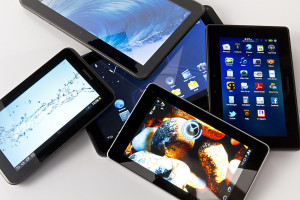 Gartner estimates that worldwide tablet sales will reach 233 million units in 2015, an 8 percent increase from 2014.
Gartner estimates that worldwide tablet sales will reach 233 million units in 2015, an 8 percent increase from 2014.
After a troubled year in 2014, the global tablet market is not returning to the levels of growth seen in the last four years as demand for tablets will continue to be slow in 2015.
“The collapse of the tablet market in 2014 was alarming,” said Ranjit Atwal, Research Director, Gartner. “In the last two years global sales of tablets were growing in double-digits. The steep drop can be explained by several factors. One is that the lifetime of tablets is being extended – they are shared out amongst family members and software upgrades, especially for iOS devices, keep the tablets current. Another factor includes the lack of innovation in hardware which refrains consumers from upgrading.”
Worldwide combined shipments of devices – PCs, tablets, ultramobiles and mobile phones – for 2015 are estimated to reach 2.5 billion units, an increase of 3.9 percent over 2014.
The mobile phone segment is on pace to grow 3.7 percent in 2015 and reach two billion units in 2016.
“The smartphone market is becoming polarised between the high- and low-end market price points,” said Annette Zimmermann, Research Director, Gartner. “On one hand, the premium phone with an average selling price at $447 in 2014 saw growth dominated by iOS, and on the other end of the spectrum you have Android and other open OS phones’ growth area in the basic phone segment, where the average phone costs $100. For the mid-range smartphones, the market opportunity is becoming increasingly limited.”
In the operating system (OS) market, Android surpassed a billion shipments of devices in 2014, and will continue to grow at a double-digit pace in 2015, with a 26 percent increase year over year.
“From 2015, we expect Windows to grow faster than iOS, as the PC market stabilises and the challenge for the next iPhone to find significant growth becomes greater, narrowing the gap between the two operating systems,” Atwal said. “We also expect development in cognizant computing (four stages: sync me, see me, know me and be me) to help the vendors’ relationships with consumers evolve from passive providers of hardware to in-sync with the user. Beyond an enriched computing experience for the user, this next phase of the personal cloud will also help make the vendor and customer’s relationships more personal, with services and advertising automatically tailored to consumer demands.”





